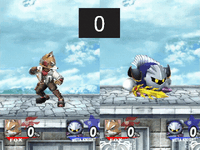
Interruptibility refers to the gameplay mechanic where an animation can intentionally be stopped prematurely and another animation immediately starts. This does not refer to unintentional moments of interruption like being hit by an attack or any visual glitch, and instead specifically refers to the player consciously deciding to stop an animation early.
OverviewEdit
Every attack in the game lasts a certain amount frames, though nearly all of them do not have to last the entire duration. If the player performs a new action during the window when the animation can be canceled, the character will snap to the first frame of the new animation. The first exact frame the interruption can occur is typically called the first actionable frame (FAF), with the term interruptible as soon as (IASA) also being used frequently. For example, while Mario's forward smash starting in Super Smash Bros. Brawl has an animation that lasts 56 frames in total, the player can perform a new action as early as frame 48, usually denoted as "FAF 48."
For most intents and purposes, the interruptible part of an animation is simply seen as filler, as the player is likely to attack, jump, or simply move as soon as possible. Many attacks have a minor amount of interruptible frames during their ending lag, while special moves and get-up animations typically do not; some attacks such as Marth's or Ness's down tilts have a significant interruptibility window which allows them to perform another action significantly faster than the animation would suggest.
In Super Smash Bros., interruptibility is not very common, only being used at the ends of some taunts and non-final neutral attacks. Super Smash Bros. Melee expanded interruptibility's applications to many attacks, and Brawl continued the idea as a common mechanic. Interruptibility continued to become even more common in Smash 4 and Ultimate. It is important to note that in terms of buffering from Brawl onwards, the window for an input to be buffered is related to interruptibility, and not the entire animation when applicable.
Interruptibility also functions differently in later games. In Melee and Brawl, interruptibility is included in the script for each animation in the main character files whereas in Smash 4 and Ultimate, interruptibility frames are included in a separate character parameter file. The main effect this difference has is that in Melee and Brawl, a move cannot be interrupted until the script reaches the interuptibility frames even if the frame value is lower than previous actions whereas this is not the case in Smash 4 and Ultimate. An example of this difference can be seen with Ganondorf's forward aerial, which can auto cancel. In Brawl and Smash 4 (and Ultimate prior to 2.0.0), the auto-cancel window of frame 55 is scripted before the interruptible window of frame 45, meaning forward aerial has an FAF of 55 in practice due to the game reading the script sequentially. The change to a separate parameter changed the FAF to 45 as always intended, indirectly buffing the attack by improving its safety.
A script command to enable interruptibility still exists within Smash 4 and the command is even still used for Wario-Man's animations. If there is an interruptibility command in an animation's script, it will override the interruptibility from the character parameter file (if it occurs earlier in the animation).
It is possible for actions to be interruptible with only certain kinds of actions and specifically not with others, such as the case with jump cancelling. This is known as selective interruptibility or limited interruptibility, though many players use the "interruptible as soon as" phrase to refer to it, which can result in confusion due to the term's history. In Melee, aerials cannot be cancelled with air dodges, while they can be in Brawl onwards. Most grounded moves (such as many down tilts) can be interrupted with a dash, jump, or other attacks, but not with some combination of shielding, walking, or turning around. Selective interruptibility is far less common from Brawl onwards with almost all attacks with interruptibility being completely interruptible although characters who can crawl cannot interrupt their down tilts with crawling (although backwards crawling works in Brawl). A character stuck in the animation of their aerial or air dodge will not be able to grab the ledge until it is completely finished, regardless if it can be interrupted much earlier. This is most prominent with Sheik's forward aerial in Smash 4.
In Super Smash Bros. and Melee, interrupting a delayed double jump results in double jump cancelling. This is no longer possible from Brawl onwards (although it can still be done with certain special moves), where doing so only interrupts the animation of the double jump (as well as any special properties it may have, such as Yoshi's knockback resistance), not the execution.
If a fighter is holding an Assist Trophy, all forms of interruptibility are temporarily disabled until the fighter uses the Assist Trophy or drops it. This extends to all attacks, all landing animations, special moves, airdodges and even hitstun animations, which tend to last for longer than the hitstun itself, effectively making hitstun greater than usual, although oddly hitstun cancelling still works as normal.
The introduction of Ryu to the series brought a new mechanic lifted from his home series called Special move canceling. This mechanic behaves similarly to interruptibility, though instead applying the animation cancel to the instant an attack connects instead of towards the end of the animation and only certain attacks can be canceled into.